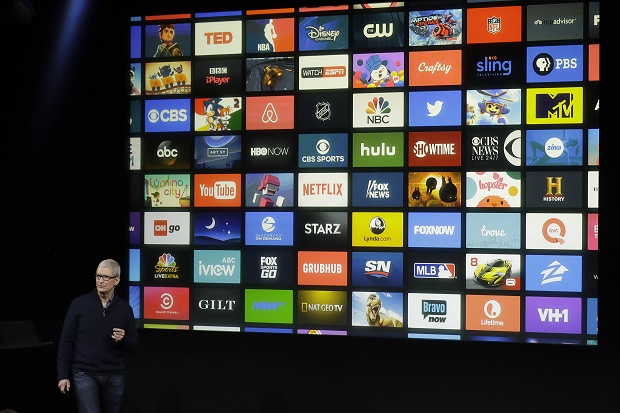
Apple CEO Tim Cook speaks about Apple TV during an announcement of new products Thursday, Oct. 27, 2016, in Cupertino, Calif. AP
CUPERTINO, California — Apple’s high-end Mac laptops are getting a touch control strip above the keyboard, part of a long-awaited update aimed at reviving interest in a product often overshadowed by newer gadgets like the iPad and iPhone.
The new Touch Bar, which is both a narrow display and a control panel, replaces the old physical function keys on a traditional laptop. It will offer a variety of controls that change according to the app or website that’s open. It also has functions that will be familiar to many iPhone users — showing word suggestions as you type, for example, or letting you scroll through a library of emojis.
New features, higher price
The company unveiled the laptops at its headquarters in Cupertino, California, where executives showed how the Touch Bar works with a variety of apps and software — providing playback and editing controls for videos or music, for example, and search functions for Apple’s maps and photos apps. Apple is also opening the Touch Bar to work with outside software, including Adobe’s Photoshop editing program and Microsoft’s Word, PowerPoint and Skype.
Along with faster processors and brighter screens, two of Apple’s new laptops will also get a fingerprint sensor, similar to the one on iPhones. The sensor can unlock the device, authorize software installations or recognize a different user and quickly switch to that person’s settings. It works with Apple Pay, so users can authorize an electronic payment for online purchases.
At least for now, the new Touch Bar and Touch ID features will be available only on higher-end models — a 13-inch MacBook Pro that starts at about $1,800 and a 15-inch MacBook Pro at about $2,400. Both ship in a few weeks. Starting Thursday, Apple is selling a 13-inch MacBook Pro without the Touch Bar or Touch ID, but with other improvements, for about $1,500.
Older versions sold for prices starting at about $1,300 for 13 inches and $2,000 for 15 inches. Apple will still sell older MacBook Pros at those prices, along with less expensive MacBook and MacBook Air models. But its cheapest laptop, the 11-inch MacBook Air for about $900, will be sold only to education markets.
The company is also replacing some computer ports with new outlets compatible with USB-C standards, which can be used both for charging and transferring data. Connectors with USB-C technology can transmit data faster than older USB jacks. They are also smaller and have a symmetric shape, which means the USB-C jack can be inserted with either side facing up. But older USB printers and other devices will need adapters. The new Macs still have traditional headphone jacks, unlike the latest iPhones.
Laptops vs. tablets
Sales of the Mac have been in a slump this year, after a streak of growth in 2014 and 2015 that seemed to defy global trends. Consumers generally are buying fewer PCs and using smartphones or tablets instead.
Apple itself has promoted its latest iPad tablet, the iPad Pro, as capable of replacing the laptop for many users. And in contrast with the Mac’s earlier years — when Apple marketed its computers to people who saw themselves as creative professionals or just independent thinkers — Apple also has begun promoting the Mac as a computer for businesses, which once mostly used competitors’ PCs running Microsoft’s Windows software.
Microsoft, meanwhile, has begun selling its own line of high-end Surface laptops and this week introduced its first Surface desktop PC. Analysts say the new Surface Studio has a premium price and features that will most likely appeal to visual designers and other creative professionals — an area that has been Apple’s strength. Microsoft has boasted about modern controls with touch screens; the Touch Bar is Apple’s answer to that, placed near the keyboard where people’s fingers are already.
For Apple, the Mac line has been eclipsed financially by other products — first the iPod and now the iPhone — that have made far more money in recent years. But the Mac has been important for Apple since co-founder Steve Jobs introduced the first model in 1984. It commands intense loyalty from fans. “The Mac is more than a product to us. It’s a testament to everything we do and everything we create at Apple,” CEO Tim Cook said Thursday.
Baby steps in TV
Cook also used the event to promote a newer endeavor, Apple TV, and a new unified menu feature that shows recommendations and new episodes of recently watched shows, so viewers don’t have to search through different apps to find them. Amazon’s Fire TV is taking a similar approach with a software update, though the unified experience will be part of the home screen, not an app.
Apple’s app, though, is short of a full-fledged streaming-TV service, which reports say Apple has been pursuing. Rather, it brings together TV shows and movies viewers already get through individual subscriptions. The TV app, coming in December, will be synced with iPhones and iPads, so viewers can catch the next episode regardless of device. Apple said its Siri voice assistant will also direct viewers to live events, such as streaming sports.
Apple said Apple TV already has 8,000 apps, including more than 2,000 games. The addictive building game “Minecraft” will come later this year.
In a minor setback, meanwhile, Apple said Wednesday that it’s delaying shipment of its new wireless earphones, called AirPods, which had been scheduled for late October. In a statement, the company said, “We don’t believe in shipping a product before it’s ready, and we need a little more time before AirPods are ready for our customers.” Apple didn’t elaborate.
RELATED STORIES